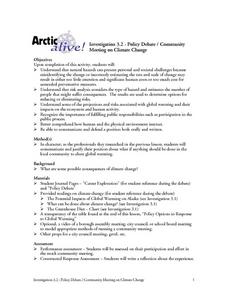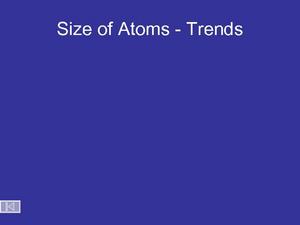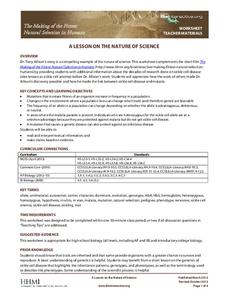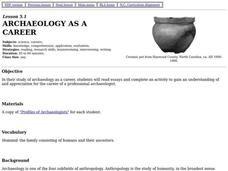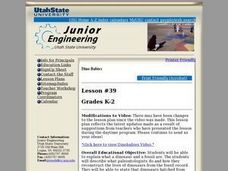Chicago Botanic Garden
Faces of Climate Change
Sometimes, the best solution to a problem can be found by walking in someone else's shoes. Here, scholars use character cards to take on the roles of people around the world. They determine how their character's...
Chicago Botanic Garden
Faces of Climate Change
You know global warming is real when your squirrel feeder is full of popped corn instead of kernels! Activity two in a series of five allows learners to explore climate change through the eyes of another. After briefly analyzing their...
Virginia Department of Education
Weather Patterns and Seasonal Changes
Get your class outside to observe their surroundings with a lesson highlighting weather patterns and seasonal changes. First, learners take a weather walk to survey how the weather affects animals, people, plants, and trees during...
Curated OER
People Change the Landscape
Students examine ways in which humans have brought change to the natural environment. In this ecology and literacy lesson, students listen to the book Island Boy by Barbara Cooney. Students observe and define map-reading vocabulary as...
Curated OER
Policy Debate / Community Meeting on Climate Change
Young scholars investigate how natural hazards can present personal and societal challenges as well as the cost involved. They assess the risk analysis considerations with global warming and their impacts on an ecosystem. An estimate of...
Population Connection
Lessons From the Lorax
Is progress progressing too fast? So believes the Lorax, the eponymous character from Dr. Seuss's The Lorax. Young environmental science students read the book and debate the arguments of the Lorax and the Once-ler regarding the...
Curated OER
Size of Atoms - Trends
This compendious collection of slides leaves no questions when it comes to the concept of atomic size. Thorough and easy-to-read graphs, tables, and graphics explain atomic radii, the shielding effect, the octet rule, isoelectric...
Howard Hughes Medical Institute
A Lesson on the Nature of Science
If you are looking for a great way to present natural selection in humans, look no further. This handout is intended to accompany the 14-minute video The Making of the Fittest: Natural Selection in Humans, which can be found on the...
Curated OER
Take Your Pick of "Beary" Fun Activities.
Students complete an integrated unit on bears. They read numerous books about bears, create a bear puppet, act-out stories, create a polar bear painting, participate in a Teddy Bear Picnic, and conduct a Teddy Bear parade.
University of California
Plankton
Plankton: so much more than just a SpongeBob character. Three different activities have kids looking at both phytoplankton and zooplankton in pictures, as well as collecting their own samples (depending on your access to a saltwater...
Curated OER
Applied Science - Science and Math Lab (read without sight)
Students consider the senses. In this sight and touch lesson, students discover what it is like to function like a person who is blind. They work in groups and individually on various activities to experience this condition. This lesson...
Curated OER
Making It Balance
Students listen to story, "The 100-Pound Problem," compare their weight with character in story, and weigh different classroom items using nonstandard units and standard units. They experiment with different items that can make scale...
Curated OER
Dr. Seuss Science
Students read Bartholomew and the OObleck by Dr. Seuss and experiment with solids and liquids. In this science and reading lesson, students observe and discuss the properties of liquids and solids. Students make predictions...
Curated OER
I Wish I Were a Butterfly
Students inquire about biology by reading a children's book in class. In this insect lesson plan, students read the story "I Wish I Were a Butterfly" and identify the unique characteristics of butterflies and other insects. Students...
Chicago Botanic Garden
Understanding the Greenhouse Effect
The greenhouse effect is important, for without it, life on Earth would not exist. An activity that includes modeling the greenhouse effect and acting out the Earth's energy balance makes up the first part in a series of seven...
Curated OER
Making Ice Cream
Student examine the physical changes of matter and are able to describe them. They make ice cream in plastic bags to observe the changes in matter. They describe and record the changes in the ice cream mixture as it freezes.
Curated OER
Archaeology as a Career
Fourth graders read about archaeology as a career. They develop a list of questions they would like to ask an archaeologist and then actually interview an archaeologist on the future of archaeology as a career.
Curated OER
The Things We Do
Fourth graders conduct a literature study in order to investigate the concept of change and how it occurs in the environment. The teacher uses the method of concept development for investigation.
Curated OER
The Art of Motion
In this motion worksheet, students write 2 or 3 techniques for showing motion in cartoons. Students also draw 3 cartoon panels of 2 automobiles on a highway, one moving at a constant speed and the other one accelerating.
Curated OER
Dino Babies
Learners distinguish between dinosaurs and fossils. They escribe what paleontologists do and how they reconstruct the lives of dinosaurs from the fossil record. In addition, they state that dinosaurs hatched from eggs.
Curated OER
Geoscience Careers
Students explore the world of geosciences and all the career possibilities and options that this field of study offers. They relate this field to engineering and other health professions. Each student utilizes technology to assist them...
Curated OER
Memory Book - A Cooperative Learning Experience
Students document sections of their life through pictures, stories, and video to create an English "memory book". They use photographs, video and edited video which includes their history, includes calculated growth, and genetic...
Purdue University
Purdue Univ: Gases, Liquids, and Solids
This site has a brief description of the differences in particles in a gas, liquid, and solid. Animated microscopic pictures demonstrate the molecular movement in each state. Information is then summarized in an easy-to-read chart.




